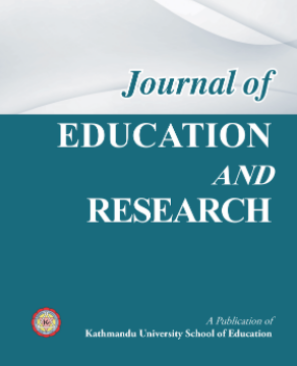
Women's Representation in Bureaucracy: Reservation Policy in Nepali Civil Service
Original Article
Journal of Education and Research, Volume 9, Issue 2, 2019, 27-48, https://doi.org/10.3126/jer.v9i2.30461
Publication date: Sep 15, 2019
Views: 634 | Downloads: 1433
How to cite this article
APA
In-text citation: (Wagle, 2019)
Reference: Wagle, S. (2019). Women's Representation in Bureaucracy: Reservation Policy in Nepali Civil Service. Journal of Education and Research, 9(2), 27-48. https://doi.org/10.3126/jer.v9i2.30461
Reference: Wagle, S. (2019). Women's Representation in Bureaucracy: Reservation Policy in Nepali Civil Service. Journal of Education and Research, 9(2), 27-48. https://doi.org/10.3126/jer.v9i2.30461
Vancouver
In-text citation: (1), (2), (3), etc.
Reference: Wagle S. Women's Representation in Bureaucracy: Reservation Policy in Nepali Civil Service. Journal of Education and Research. 2019;9(2):27-48. https://doi.org/10.3126/jer.v9i2.30461
Reference: Wagle S. Women's Representation in Bureaucracy: Reservation Policy in Nepali Civil Service. Journal of Education and Research. 2019;9(2):27-48. https://doi.org/10.3126/jer.v9i2.30461
AMA
In-text citation: (1), (2), (3), etc.
Reference: Wagle S. Women's Representation in Bureaucracy: Reservation Policy in Nepali Civil Service. Journal of Education and Research. 2019;9(2), 27-48. https://doi.org/10.3126/jer.v9i2.30461
Reference: Wagle S. Women's Representation in Bureaucracy: Reservation Policy in Nepali Civil Service. Journal of Education and Research. 2019;9(2), 27-48. https://doi.org/10.3126/jer.v9i2.30461
Chicago
In-text citation: (Wagle, 2019)
Reference: Wagle, Samjhana. "Women's Representation in Bureaucracy: Reservation Policy in Nepali Civil Service". Journal of Education and Research 2019 9 no. 2 (2019): 27-48. https://doi.org/10.3126/jer.v9i2.30461
Reference: Wagle, Samjhana. "Women's Representation in Bureaucracy: Reservation Policy in Nepali Civil Service". Journal of Education and Research 2019 9 no. 2 (2019): 27-48. https://doi.org/10.3126/jer.v9i2.30461
Harvard
In-text citation: (Wagle, 2019)
Reference: Wagle, S. (2019). Women's Representation in Bureaucracy: Reservation Policy in Nepali Civil Service. Journal of Education and Research, 9(2), pp. 27-48. https://doi.org/10.3126/jer.v9i2.30461
Reference: Wagle, S. (2019). Women's Representation in Bureaucracy: Reservation Policy in Nepali Civil Service. Journal of Education and Research, 9(2), pp. 27-48. https://doi.org/10.3126/jer.v9i2.30461
MLA
In-text citation: (Wagle, 2019)
Reference: Wagle, Samjhana "Women's Representation in Bureaucracy: Reservation Policy in Nepali Civil Service". Journal of Education and Research, vol. 9, no. 2, 2019, pp. 27-48. https://doi.org/10.3126/jer.v9i2.30461
Reference: Wagle, Samjhana "Women's Representation in Bureaucracy: Reservation Policy in Nepali Civil Service". Journal of Education and Research, vol. 9, no. 2, 2019, pp. 27-48. https://doi.org/10.3126/jer.v9i2.30461
ABSTRACT
This paper analyses women's representation in Nepali bureaucracy after the implementation of the reservation policy in 2007. The motivation behind the reservation was that people from marginalized and weaker section of the society should be uplifted. Moreover, representative bureaucracy refers to a bureaucracy that embodies the demographic structure of the society. Following descriptive research method, I collected data from secondary sources such as annual reports and other publications of Public Service Commission, Nepal. The amendment of Civil Service Act-1993 in 2007 with the provision of 45 per cent reservation of civil service seats for women along with indigenous community, Madhesi, Dalit, disabled people and people from backward areas has resulted in the growing number of women’s participation. The growing number of women civil servants in the recent years is expected to change the landscape of civil service in near future. Implications for public administration research and practice are discussed.
REFERENCES
---
LICENSE
This work is licensed under a Creative Commons Attribution 4.0 International License.
